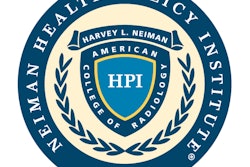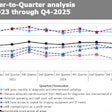Medical societies and experts are watching closely as the U.S. Centers for Medicare and Medicaid Services (CMS) reviews comments submitted regarding the 2026 Physician Fee Schedule (PFS) and Quality Payment Program (QPP) proposed rule.
Several societies in September submitted their comments to CMS, with focus on a proposed efficiency adjustment and two imaging specialties being included as Merit-based Incentive Payments System (MIPS) Value Pathways (MVPs).
“We really worked closely with the agency and with their contracted organizations together, so we thought we were talking closely to them and having bi-directional feedback,” said Lauren Nicola, MD, a member of the American College of Radiology (ACR) Commission on Economics. “It was disappointing that our suggestions were not incorporated into the final version [of the proposed rule].”
Efficiency adjustment
Part of the CMS’s rule for 2026 includes the introduction of an efficiency adjustment that will reduce work relative value units (RVUs) and intraservice time related to work RVUs for non-time-based codes by 2.5%. The CMS estimates that this adjustment would reduce overall payments to most specialties by up to 1%. The adjustment would impact over 7,000 codes for medical services.
Nicola said there are “a lot of reasons” why medical societies such as the ACR believe this adjustment may not improve efficiency.
Lauren Nicola, MD, from the ACR, explains why the CMS's proposed efficiency adjustment may not lead to gains in efficiency for radiology practices.
The Medical Group Management Association (MGMA) also expressed concern about the efficiency adjustment. In its submitted comments, the association said the adjustment is “an unfounded cut” to all non-time-based codes.
James Haynes, associate director of government affairs at the MGMA, said the cuts will be too broad and undermine practices. He added that the adjustment will introduce new administrative complications for productivity and compensation plans.
“We don’t believe it [adjustment] reflects the reality of a lot of these codes, given that numerous specialties have raised concerns about how there aren’t these efficiencies,” Haynes said.
The Radiology Business Management Association (RMBA) meanwhile called the efficiency adjustment "arbitrary and not resource-based. It also said the adjustment misapplies economic productivity metrics to clinical practice and fails to account for increased complexity, after hours demands, and rising practice expenses."
"RBMA urges CMS to reconsider this proposal, as it undermines Congress’ intent, adds unnecessary regulatory complexity, and risks worsening the radiologist workforce shortage and access issues for Medicare beneficiaries," the association stated in its submitted comments.
New conversion factors
The CMS is instituting two conversion factors for 2026 as required by the Medicare Access and CHIP Reauthorization Act of 2015 (MACRA). One is for qualifying Alternative Payment Model (APM) participants (QPs), including a 0.75% increase in adjustment. The other factor for non-QPs consists of a 0.25% increase in adjustment.
CMS is proposing a conversion factor of $33.59 for QPs and $33.42 for non-QPs -- an increase of $1.24 (3.83%) for QPs and $1.07 (3.32%) for non-QPs over the 2025 conversion factor of $32.34.
The increase to the conversion factor includes a 0.55% positive adjustment necessary to account for changes in misvalued codes and a newly introduced efficiency adjustment. It also includes the 2.5% increase to the 2026 Medicare PFS from the One Big Beautiful Bill Act (OBBBA).
The MGMA in its comments said these adjustments do not remedy previous cuts that physician groups have absorbed “due to flawed policy.” The proposed rule also does not address potential future cuts due to budget neutrality, the association added.
The RBMA meanwhile recommended that CMS provide "clear and consistent guidance" to providers and Medicare Administrative Contractors regarding claims processing and conversion factor determinations.
"RBMA also urges CMS to develop pathways that allow specialty physicians, including radiologists, to meaningfully participate in APMs so they may qualify for the higher conversion factor, recognizing their vital role in patient care," the association stated. "Additionally, RBMA supports the Prompt and Fair Pay Act and recommends that Medicare Advantage plans reimburse providers at the higher conversion factor, aligning their payment structures with those of APMs."
And radiation oncology also faces changes, with coding changes to superficial radiation and orthovoltage radiation therapy.
Amar Rewari, MD, health policy vice-chair for the American Society for Radiation Oncology (ASTRO), said these cuts would affect patient care by discouraging funding allocations toward new research and equipment, as well as affecting overhead costs for staffing. Rewari is also the co-host of the Value Health Voices podcast.
Amar Rewari, MD, from ASTRO explains how cuts in reimbursement can impact patient care by introducing more costs to practices.
Imaging gets nod for MVPs
The CMS also named six new MIPS Value Pathways (MVPs), including diagnostic radiology and interventional radiology. MVPs are an optional reporting framework for the Merit-based Incentive Payment System (MIPS) that is meant to reduce reporting burden on clinicians, including radiologists. These pathways also aim to encourage more high-quality and lower-cost care by reducing the number of quality measures a group or individual provider must submit to the CMS for scoring.
However, some are not on board with the model’s current setup. The Society of Interventional Radiology (SIR), in its submitted comments, opposed the specialty’s inclusion as an MVP due to “its lack of consideration for the breadth of interventional radiology or how interventional radiologists practice.”
“The MVP system uses measures that require a lot of effort and money, frankly, in the low six figures just to create a single measure for a QPP or for these MVPS,” said Rajesh Shah, MD, quality division chair for SIR. “It’s a very expensive and time-consuming process to create these measures.”
Rajesh Shah, MD, from the SIR explains how moving to an MVP could have unintended consequences for interventional radiologists.
And Erin Stephens, senior client manager for education at Healthcare Administrative Partners (HAP), said that the success of being an MVP depends on how individual practices are performing on traditional MIPS measures.
“They are not the easiest reports and require a lot of documentation to be in the finalized dictated reports,” Stephens said.
She added that radiologists are busy with increasing imaging volumes, especially with CT and MRI, which these MIPS quality measures typically fall into.
“Our focus as radiologists is to give a great interpretation and help clinically paint the picture for our patients,” Stephens said. “So, they kind of forget about MIPS sometimes. So, in that radiology MVP, we have some of the traditional MIPS measures that have been difficult for radiologists to get on board with.”
Next steps
Nicola said the ACR will continue to address concerns to the CMS and work to educate its members on how the final rule will impact practices. She added that the ACR will work with other medical societies to achieve common goals.
“We work with the agency [CMS] very closely and give feedback frequently,” she said.
Haynes said the MGMA will continue to advocate for improving policies toward health and work with CMS in addressing concerns.
“We’ll see what happens in early November. We’ll continue working on a lot of these issues,” he said.
James Haynes from the MGMA talks about the importance of advocacy when making recommendations toward health policy.
And SIR is using its VIRTEX clinical data registry and analytics platform to create measures by ingesting large volumes of data with the goal of improving patient care among interventional radiologists while also being cost-effective.
“We’re seeing increases in sub-specialization in things like pediatrics and oncology,” Shah said. “It’s up to us to provide the measures that demonstrate the value that those particular areas are providing for things like the MVP.”
Rewari said ASTRO will also work with CMS on recommendations for the final rule. This also includes continuing to advocate for the Radiation Oncology Case Rate (ROCR) value-based payment model.




















